Well, we are officially on our way home. We are currently in London for a quick day trip and some sight seeing. No time for Stonehenge, but we are heading over to the Victoria & Albert Museum this morning before we head back to Heathrow for our flight to Seattle this evening. We wish we had more time to look around in London, but at the same time we are both excited to head home to our friends and families.
Our trip to India has been a huge success. The people we met on the trip were fantastic and amazing hosts! We had the privilege to spend time with their families and to learn more about the Indian culture. It was great to be immersed in it. We certainly saw real Indian life, ate real Indian food (lots of it) and had a real Indian good time. The people we met on this trip have truly made it a success.
To those we met and spent time with in India, thank you. We had a great time and we hope to return soon.
Wednesday, February 28, 2007
Saturday, February 24, 2007
Homeward bound!
Ok so its not actually until tomorrow evening that we will be starting the journey home, but I'm just ready to say "Homeward bound". I am so excited to be heading home! Tomorrow night (which is the 26th here) we will fly to Mumbai, spend the evening there, then the following day we fly from Mumbai to London. Paul has arranged our tickets so that we have an overnight in London before flying the following day to Seattle. This way we will have a chance to go into London (okay so maybe I could've visited London last time instead of sleeping at the airport if I were as super-keen as Paul!) In London we will try to visit the Victoria & Albert Museum of Applied Arts. And eat anything but Indian food. We will leave London around 4pm on wednesday the 28th, and will arrive in Seattle around 5pm the same day in local time. That will be the longest one hour ever! If we don't get a chance to write before we arrive home, our next post should be on wednesday evening the 28th. Until then!
Thursday, February 22, 2007
4 more days!
Well now we only have 4 days to go, and I don't think I could eat another masala dosa. Certainly not another aloo gobi (potato cauliflower in spicy gravy sauce.) I am so much looking forward to eating a fresh crisp salad with apples and goat cheese. Paul really wants a cheeseburger. This is the longest he's ever gone without eating meat! (Oh my, we'll have to change that.) 4 more days, still a busy time to go... I will be checking out some hand quilting, machine quilting, and other stitchery, while Paul will be strategizing and making graphs and spreadsheets and other businessy type stuff. We may both need a vacation after this!
A few corrections...(by Leah)
Here are a few corrections from previous entries that I thought I'd post in one go...
1. India's birthday is actually Independence Day (August 15th,) not Republic Day (January 26th.) Oops.
2. There actually ARE traffic lights in Ahmedabad, but they have only been here for the past year or two, and so they seem to be largely ignored. (Which is why I hadn't noticed them I guess!)
3. Organic cotton may not be that likely to replace conventional cotton farming within 20 years time. This was one very hopeful perspective (which we liked very much!) but after further enquiry, it seems that it may not be that accurate of a projection. Although organic farming clearly looks better in the long term than conventional farming does, it also requires more commitment, attention, observation, care, and manual labour in order to work, as well as a transitional period that can be a difficult gap to pass through. This effort and level of commitment may not be that attractive to all farmers, especially the large-scale farms. We'll see about those 20 years...
4. I can't take the credit for the "master-planning" of this trip- the planning for these two weeks while Paul is here was done mostly by our hosts in Ahmedabad, as well as their contacts with whom we've met. It's so nice that Paul thinks I could pull that off though!
1. India's birthday is actually Independence Day (August 15th,) not Republic Day (January 26th.) Oops.
2. There actually ARE traffic lights in Ahmedabad, but they have only been here for the past year or two, and so they seem to be largely ignored. (Which is why I hadn't noticed them I guess!)
3. Organic cotton may not be that likely to replace conventional cotton farming within 20 years time. This was one very hopeful perspective (which we liked very much!) but after further enquiry, it seems that it may not be that accurate of a projection. Although organic farming clearly looks better in the long term than conventional farming does, it also requires more commitment, attention, observation, care, and manual labour in order to work, as well as a transitional period that can be a difficult gap to pass through. This effort and level of commitment may not be that attractive to all farmers, especially the large-scale farms. We'll see about those 20 years...
4. I can't take the credit for the "master-planning" of this trip- the planning for these two weeks while Paul is here was done mostly by our hosts in Ahmedabad, as well as their contacts with whom we've met. It's so nice that Paul thinks I could pull that off though!
Wednesday, February 21, 2007
The entire process - a pictorial
Well, its official. We have seen every step in the chain from Organic cotton farming through to Stitching. Here is a quick snapshot of each stage, all of which we have seen in the past week first hand. Amazing.
Organic Cotton Farming

Cotton Ginning

Spinning
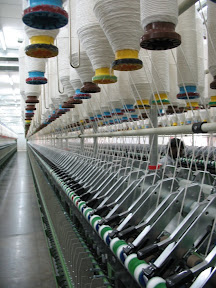
Traditional Weaving
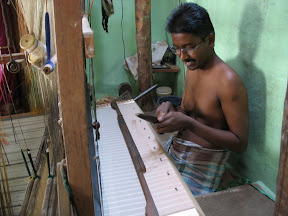
Mechanical Weaving
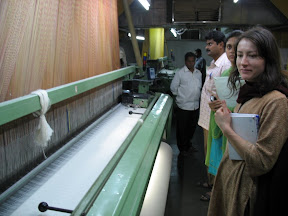
Mechanical Knitting
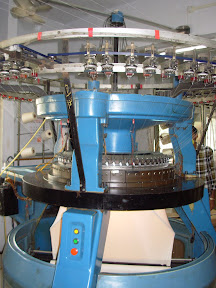
Chemical Dyeing (We will never, ever do this!)
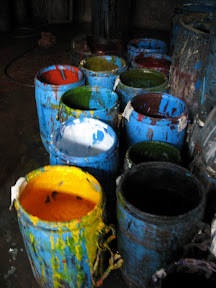
Natural Dyeing
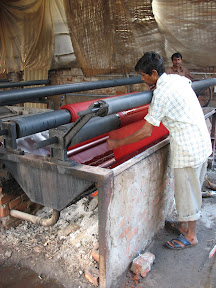
Screen Printing
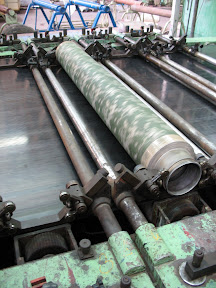
Cutting

Stitching
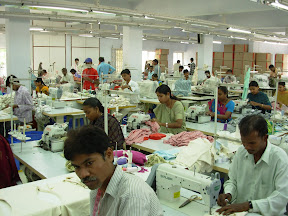
All of these photos and more are on our Picasa Web album.
Organic Cotton Farming

Cotton Ginning

Spinning

Traditional Weaving

Mechanical Weaving

Mechanical Knitting

Chemical Dyeing (We will never, ever do this!)

Natural Dyeing

Screen Printing

Cutting

Stitching

All of these photos and more are on our Picasa Web album.
Monday, February 19, 2007
Photos, lots of 'em
Here is a link to our web album where we are collecting a selection of our best photos from the trip. Check back every once in a while for new additions...
http://picasaweb.google.com/paularonw/TenfoldGoesToIndia02
http://picasaweb.google.com/paularonw/TenfoldGoesToIndia02
Indore, the long road, and organic farming
Paul and I arrived in Indore on Sunday morning, where we were greeted by the project manager of an organic farming project. We then went pretty much directly from Indore to our destination, which was in village outside of Indore, to visit an organic farm. Although the village was only around 150 kms outside of Indore, it ended up taking us about 6 hours to get there. I guess it was because of the single lane road for a substantial part of the way, our 2 stops at temples along the way (Jain temples that our host implied he was hoping would inspire us to convert to his religion) one tea stop, and one lunch stop. Also I think the 800 sheep, 150 goats, 80 camels and 45 cows that took over the road at different points along the way had something to do with the slow going as well. A visual feast, although very bumpy and windy. Needless to say, we were both very happy to get out of the car after the way there, as well as after the way back, the following day.
The organic farm we visited was very interesting and added yet another layer to the picture on organic farming. Our host stated that he believes that organic cotton farming will (not only can, but will) replace conventional cotton farming within 20 years time. This gives us great hope! The reason why he holds this belief is because it is so clear that conventional cotton farming is unsustainable, and cannot continue as it is going without addressing major issues of soil fertility. The concept of applying chemicals to plants and soil to kill pests, which in addition kills all of the beneficial insects, harming the birds which feed on those insects, the essential benefical bacteria and enzymes in the soil which give life to the soil, and the worms which add numerous benefits to the soil including the ability for the soil to retain water- in light of these effects of the application of chemicals, it seems absolutely necessary that organic farming practices replace conventional practices.
Conventional cotton farming, which relies heavily on chemical pesticides and fertilizers, has only been around for a few decades. Prior to this, all farming was based on organic means, so it is not that far off, however, India has seen quite a change in farming practices in that short period. The "Green Revolution" which happened in India in the 60's and 70's, turned farmers on to chemical methods of controlling pests, which in turn requires the use of synthetic fertilizers. The use of chemicals has resulted in infertile soil which lacks the ability to sustain itself, thus becoming dependant on the application of very strong and expensive chemicals. As the soil becomes uninhabitable for worms, so it also becomes very dry and not as able to hold moisture. Thus rains fall yet are not absorbed, and more water is needed to irrigate the soil. Also, as pests become immune to the pesticides, insecticides, and fungicides, new, stronger concoctions are required to keep them at bay. This in turn makes the soil even less fertile which creates a downward spiral. In the worst case, which is not uncommon, it leads the farmer to such despair that he chooses to take his own life. Farmer suicides in India are linked to conventional cotton farming practices, and "at least 500 cotton farmers have committed suicide in the state of Maharashtra since June 2005."- source:http://www.wsws.org/articles/2006/may2006/indi-m12.shtml) This shocking reality is another clear indicator that change is needed.
Some concepts of organic farming:
The principles of Bio-Dynamics seem to have been embraced throughout India in the organic farming movement. This is a very fascinating philosophy and approach to organic farming which I am still learning about. For more info, check out the website: http://www.biodynamics.com/biodynamics.html. This website explains bio-dynamism so eloquently that I can only say: go check it out! All three of the organic farms I have visited in India have embraced the principles of bio-dynamism. Using cow's manure, cow's urine, wormy peat, wormy wash (water drained from the wormy peat), fermented buttermilk, fermented neem leaves, and a whole range of other fermented ingredients, concoctions are created to bring life back to the soil, and to ward off pests. Bio-dynamism is essentially a spiritual approach to organic farming, which seems to be readily embraced in India by a land that seamlessly ties the spiritual into everyday life. Gods, Goddesses, prayers, flowers, ceremonies, and incense- everywhere in India the spiritual is celebrated in the everyday. Even in the rickshaws little shrines are displayed as shiny stickers and strings of flowers along the dash. An organic approach just fits here. Of course, chemicals also seem to fit in very well, as India is also a paradox. It will take committment and perseverance to make that organic vision a reality.
The organic farm we visited was very interesting and added yet another layer to the picture on organic farming. Our host stated that he believes that organic cotton farming will (not only can, but will) replace conventional cotton farming within 20 years time. This gives us great hope! The reason why he holds this belief is because it is so clear that conventional cotton farming is unsustainable, and cannot continue as it is going without addressing major issues of soil fertility. The concept of applying chemicals to plants and soil to kill pests, which in addition kills all of the beneficial insects, harming the birds which feed on those insects, the essential benefical bacteria and enzymes in the soil which give life to the soil, and the worms which add numerous benefits to the soil including the ability for the soil to retain water- in light of these effects of the application of chemicals, it seems absolutely necessary that organic farming practices replace conventional practices.
Conventional cotton farming, which relies heavily on chemical pesticides and fertilizers, has only been around for a few decades. Prior to this, all farming was based on organic means, so it is not that far off, however, India has seen quite a change in farming practices in that short period. The "Green Revolution" which happened in India in the 60's and 70's, turned farmers on to chemical methods of controlling pests, which in turn requires the use of synthetic fertilizers. The use of chemicals has resulted in infertile soil which lacks the ability to sustain itself, thus becoming dependant on the application of very strong and expensive chemicals. As the soil becomes uninhabitable for worms, so it also becomes very dry and not as able to hold moisture. Thus rains fall yet are not absorbed, and more water is needed to irrigate the soil. Also, as pests become immune to the pesticides, insecticides, and fungicides, new, stronger concoctions are required to keep them at bay. This in turn makes the soil even less fertile which creates a downward spiral. In the worst case, which is not uncommon, it leads the farmer to such despair that he chooses to take his own life. Farmer suicides in India are linked to conventional cotton farming practices, and "at least 500 cotton farmers have committed suicide in the state of Maharashtra since June 2005."- source:http://www.wsws.org/articles/2006/may2006/indi-m12.shtml) This shocking reality is another clear indicator that change is needed.
Some concepts of organic farming:
The principles of Bio-Dynamics seem to have been embraced throughout India in the organic farming movement. This is a very fascinating philosophy and approach to organic farming which I am still learning about. For more info, check out the website: http://www.biodynamics.com/biodynamics.html. This website explains bio-dynamism so eloquently that I can only say: go check it out! All three of the organic farms I have visited in India have embraced the principles of bio-dynamism. Using cow's manure, cow's urine, wormy peat, wormy wash (water drained from the wormy peat), fermented buttermilk, fermented neem leaves, and a whole range of other fermented ingredients, concoctions are created to bring life back to the soil, and to ward off pests. Bio-dynamism is essentially a spiritual approach to organic farming, which seems to be readily embraced in India by a land that seamlessly ties the spiritual into everyday life. Gods, Goddesses, prayers, flowers, ceremonies, and incense- everywhere in India the spiritual is celebrated in the everyday. Even in the rickshaws little shrines are displayed as shiny stickers and strings of flowers along the dash. An organic approach just fits here. Of course, chemicals also seem to fit in very well, as India is also a paradox. It will take committment and perseverance to make that organic vision a reality.
Subscribe to:
Posts (Atom)
